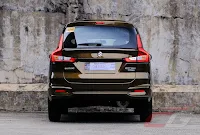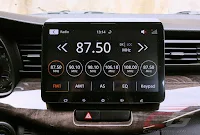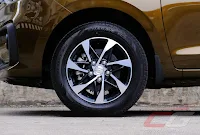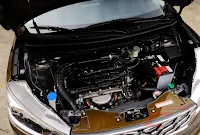The MPV segment is on fire these days, and each car manufacturer has come up with their own unique twist to help them stand out from the crowd. At the same time, buyers started demanding more than just flexibility in their MPV, and nowadays, they expect styling, performance, and of course, fuel economy too. In short, they want an all-in-one vehicle. The question is, can the new Suzuki Ertiga Hybrid heed that call?
Let’s start with the most talked about aspect: the powertrain. As the country’s first compact hybrid MPV, there’s a certain level of expectation here, particularly in the aspect of fuel economy. In that regard, the Ertiga Hybrid delivers. Suzuki Philippines reckons that it’ll do 12.54 km/L loaded with seven adults in city traffic—a 7.6 percent improvement over its non-hybrid counterpart. In our experience, it’s even better. At 16.12 km/L—it’s a 60 percent jump over the 10-ish km/L we were able to do with the previous Ertiga. A big part is down to the carmaker’s decision to lend it to us during a weekend (Friday to Monday) and our average speed—22 km/h reflects that. These figures will surely go down during weekday traffic, but overall, owners can truly expect less trips to the gas stations. But when you do, it is best to go for a fuel that is designed to maximize its fuel efficiency like Petron XCS.
The Ertiga’s secret is the Smart Hybrid Vehicle by Suzuki or SHVS system. The name’s clunky, but what’s important to remember is that it’s a hybrid system that pairs their tried-and-tested 1.5-liter K15B engine with an Integrated Starter Generator or ISG. As a caveat, it’s a mild hybrid meaning its driven wheels can’t be motivated by electrical power alone; the ISG merely provides an assist to the combustion engine. But even compared to other similar setups, the SHVS is the mildest one yet. It doesn’t power down the engine as you coast to a stop (it only switches off the engine when you’re already completely still), nor does it use the brakes to recoup energy to recharge the lithium-ion battery (it only uses deceleration).
This setup presents drivers a unique set of pros and cons. On the pros side, it offers a very gentle learning curve. The driving experience is the same as the non-hybrid Ertiga with some minor exceptions such as the engine shutting off and turning back on automatically during traffic stops, better low-end torque thanks to the electrical assist provided by the ISG, and maintenance costs comparable to its non-hybrid counterpart. On the cons side, it doesn’t really maximize the whole hybrid setup since braking energy is still wasted (though the transmission automatically decouples during coasting). Also, because of its rudimentary 12-volt setup, less power is transmitted through the system which means things like the aircon compressor still powers down during longer stops—something that doesn’t happen in a 48- or even 24-volt setup.
Now that we’ve taken the time to explain the SHVS tech, it’s time to describe how it behaves on actual road conditions. The Ertiga Hybrid has a strong initial pull, making it great in stop-and-go traffic. Even with three people on board, it shows little signs of getting strained; a good sign given its positioning as 7-seater MPV. Compared to the non-hybrid version which requires a good shove of the accelerator, this one’s more relaxed. The 4-speed automatic, though smooth, can be lazy at times during downshifts. Usually, it takes a strong tap of the accelerator to coax a downshift. Treat it sensibly though, and it’ll keep the engine singing at the right note. Sadly, Suzuki still missed the opportunity to install a manual shift override here.
As for its handling, it’s generally positive. It’s definitely tuned for comfort—a plus for Filipino families. The softly sprung suspension is pliant and composed even when going through rough patches of road. It’s also remarkably quiet too, though the glass is so thin, you can make out what cyclists and some pedestrians are talking about around you. On the other hand, Suzuki’s decision to go 100 percent on cushiness means it’s no Swift through corners. It tips and rolls through bends, with copious amounts of understeer. Mind you, it’s no deal breaker, but it’s by no means the sharpest tool in the shed. The steering, though precise, is a bit too light. Thankfully, it happens to weigh up nicely at speed.
When it comes to design, the Ertiga Hybrid hasn’t really changed much from 2019. Of course, it’s managed to receive a very minor refresh and that’s seen in the new grille, chrome tailgate garnish, and two-tone polished 15-inch alloy wheels. Furthermore, it doesn’t really shout out its green credentials; there’s a solidary “Hybrid” tailgate badge, and that’s it. It’s laudable that Suzuki’s gone this route, but we can imagine it’ll confuse traffic enforcers (it’s supposedly exempt from the number coding scheme per Suzuki). Heck, it can even lead non-hybrid Ertiga owners to slap on their very own “Hybrid” emblem just to get a number coding pass. We think Suzuki just opened a can of worms right here.
The same thing can be said about the Ertiga Hybrid’s interior. Because the SHVS is so lightweight and compact, the cabin’s the same as the non-Ertiga Hybrid in terms of interior room, space, and flexibility. The two-tier cargo floor frees up to 199 liters of room, enough to fit a typical luggage upright. Fold the third row down, and it’s up to 550 liters. Fold the second and third row seats, and you get 803 liters—the same numbers as the non-hybrid Ertiga. Oh, and if you’re looking for where the lithium-ion battery is? It’s underneath the driver’s seat. Onto the second row, it operates with a single-action lever that slides and moves the seats by 240 millimeters to aid access to the third row. Over to the third row, the seatbacks recline 16 degrees, and steel panels integrated into the second- and third-row seatbacks help keep bulky items stable when loaded.
Settling in, the Ertiga Hybrid has the same flat-bottomed steering wheel, sweeping wood trim, vertically-resting dials, and elongated AC vents as before, but there are some new things like the 4.2-inch colored multi-information display and an automatic climate control for the front occupants (the rear has a ceiling-mounted blower). Ergonomically, it’s pretty straightforward and easy-to-understand, but we’d trade an inch or two off from the outlandishly-sized infotainment system (10-inches) for a proper day/night rearview mirror.
Feature-wise, it’s hard to criticize what Suzuki’s done with the Ertiga Hybrid. Prices are up roughly P 100,000 across the board, but at P 1,153,000 for this top-of-the-line 1.5 GLX, it’s still not bad. It’s got the sort of convenience features sought after by any modern family right down to electronic stability control and rear parking sensors with a back-up camera. Again, we’d like to point out what somehow Suzuki chose to omit the rearview mirror’s anti-dazzle function—a feature that’s pretty much commonplace on any other modern automobile.
The realm of MPVs, the Ertiga ticks the right boxes: cleverly-designed, flexible, and fuel efficient. But helping them raise their game this time around is the SHVS. Though Suzuki didn’t manage to maximize the potential of the setup, it does make electrification a truly mainstream option for Filipino families. Moreover, what’s more important is that the system works on a practical day-to-day basis.
And given the modest price jump, it transforms this once good value MPV into a great one. Plus, because the Ertiga Hybrid happens to benefit from the EVIDA implementing rules and regulations (again, per Suzuki), you stand to benefit from more affordable registration frees and you’re also exempt from the number coding scheme as well. These two alone make it a win-win for would be MPV buyers.
|
2023 Suzuki Ertiga Hybrid 1.5 GLX |
|
| Bottom Line | |
| Pros | Good value for money, excellent observed fuel efficiency. |
| Cons | Suzuki didn't maximize the hybrid setup, where's the day/night rearview mirror?! |
| TL;DR | It's not exciting, but it is practical. |
| Ownership | |
| Year Introduced | 2019 (Refreshed: 2020, 2023) |
| Warranty | 3 years / 100,000 kilometers |
| The Basics | |
| Body Type | 5-door MPV |
| Seating | 7 |
| Engine / Drive | F/F |
| Under the Hood | |
| Displacement (liters) | 1.5 |
| Aspiration | Normally Aspirated |
| Fuel Delivery | EFI |
| Layout / # of Cylinders | Inline-4 |
| BHP @ rpm | 103 @ 6,000 |
| Nm @ rpm | 138 @ 4,400 |
| Fuel / Min. Octane | Gasoline / 91~ |
| Transmission | 4AT |
| Cruise Control | Yes |
| Fuel Economy (km/L) @ Ave. Speed (km/h) |
16.12 km/L @ 22 km/h (fueled with Petron XCS) |
| Dimensions and Weights | |
| Length (mm) | 4,395 |
| Width (mm) | 1,735 |
| Height (mm) | 1,690 |
| Wheelbase (mm) | 2,740 |
| Curb Weight (kg) | 1,170 |
| Suspension and Tires | |
| Front Suspension | Independent, MacPherson Strut |
| Rear Suspension | Torsion Beam Axle |
| Front Brakes | Vented Disc |
| Rear Brakes | Drum |
| Parking Brake | Hand-Type |
| Tires | Dunlop Enasave EC300+ 185/65 R 15 H (f & r) |
| Wheels | Alloy |
| Safety Features | |
| Airbags | 2 |
| Anti-Lock Brakes (ABS) | Yes, with EBD |
| Traction / Stability Control | Yes |
| Parking Sensors | Yes, Rear |
| Parking Camera | Yes, Rear |
| Front Seatbelts | 3-pt ELR w/ pre-tensioners x 2 |
| Rear Seatbelts |
3-pt ELR x 2 + 2-pt Lap
Belt x 1 (2nd row), 3-pt ELR x 2 (3rd row) |
| ISOFIX Child Seat Anchor | Yes |
| Other Safety Features | None |
| Exterior Features | |
| Headlights | Halogen |
| Fog Lamps | Yes, Halogen (Front) |
| Light Operation | Auto On/Off |
| Wiper Operation | Variable, Fixed |
| Tailgate | Manual |
| Interior Features | |
| Steering Wheel Adjust | Tilt |
| Steering Wheel Material | Wood/Leather |
| Seating Adjustment (driver) | Manual, 6-way |
| Seating Adjustment (front passenger) | Manual, 4-way |
| Seating Surface | Fabric |
| 2nd Row | 60/40 Split-Fold, Tilt, Sliding, Reclining, w/ Arm Rest |
| 3rd Row | 50/50 Split-Fold, Reclining |
| Sunroof | No |
| Multi-Information Display | Yes |
| Convenience Features | |
| Power Steering | Yes |
| Power Door Locks | Yes |
| Power Windows | Yes |
| Power Mirrors | Yes, w/ Fold |
| Rear View Mirror | Fixed |
| Proximity Key | Yes |
| Climate Control | Automatic (Front), Manual (Rear) |
| Audio System |
Stereo USB Aux Bluetooth |
| Smartphone Connectivity |
Apple CarPlay Android Auto |
| # of Speakers | 6 |
| Steering Controls | Yes |


























Even without that small Lithium-ion battery, the other added features & upgrades compared to the non-hybrid version is worth the 100K increase, although the omission of the manual day/night rearview mirror is really odd.
ReplyDeleteUly, did you ask Suzuki PH how much that Li-Ion battery costs when it need to be replaced, it is really small so it shouldn't cost an arm & a leg, I have portable powerbanks that have a bigger capacity.
They said it'll last the life of the car, but offhand, they were quoting something like 120K. Nothing solid yet though.
DeleteWow, still pricey. I got a 6Ah powerbank from Lazapee for just 2.5k php.
Delete120K for the Li-Ion battery? WTH! That might just cancel the savings in the increased mileage. Geez.
Deletethat's cheap compared to Tesla's battery replacement cost lmao, lol even
Deletebut the difference is, tesla is fully electric, while ertiga is just a measly hybrid, it doesnt even have that big of a battery.
DeleteI don't know how suzuki did it, but it managed to make a vehicle with absolutely no sex appeal.
ReplyDeleteHahaha! It's not meant to be sexy. It's just meant to be practical.
DeleteWow, you've never seen a Mobilio or previous-gen Avanza before?
Delete@Vin weren't you a diehard mazda fanboy? Why the sudden interest in a boring mpv?
DeleteSeems like the Ertiga Hybrid will sell well.
ReplyDeleteDo we have any numbers on how much the PMS and other stuffs for maintenance this New Ertiga Hybrid Cost? Thanks for reply!
ReplyDeleteApparently, Suzuki has higher PMS cost, in-fact, substantially higher (compared to Toyota) if you follow the dealership suggestion.
ReplyDeleteJust purchased an Ertiga. When car is parked is it soar on battery to run the air con for long periods of time?
ReplyDeleteDid anyone notice the odd position of the pedals? Good car, but I just don't like the pedals. The brake position seems high. Just an observation and may not be true for all.
ReplyDeleteI have concern about my 2023 hybrid GL version.. my mileage is only at 8km/L on a moving traffic even on a non traffic midnight im only able to get 10~11 .. its not about how i stepped on the gas pedal,(im into fuel economy, i can even get 11km/L on a 2017 at ecosport this is bnew btw not even reached 1000km yet ..
ReplyDeleteSame with me.. I'm on an economy type of driving.. on a city, I only got 10km/L and 12 km/l for long drive.. :(
Delete